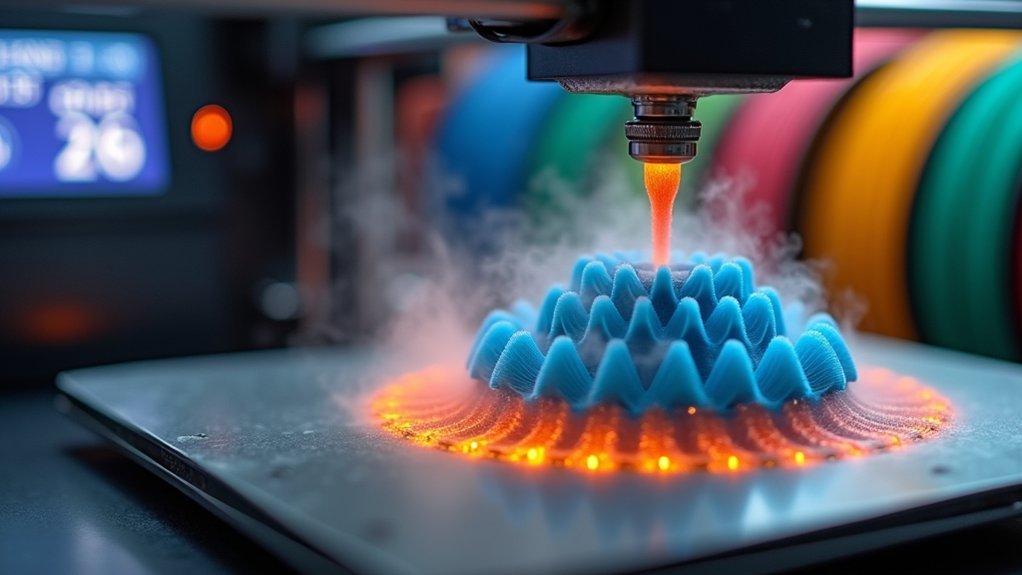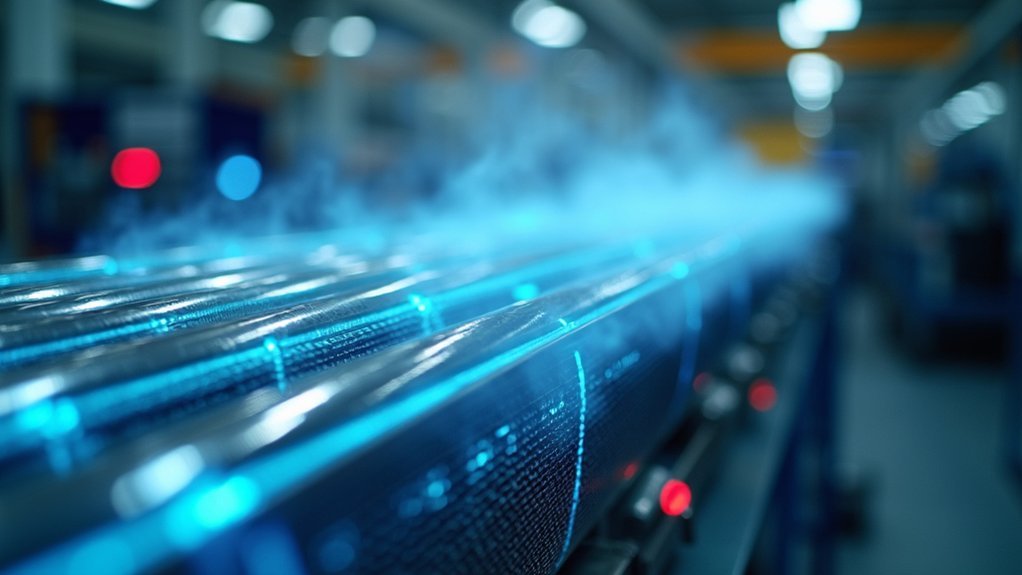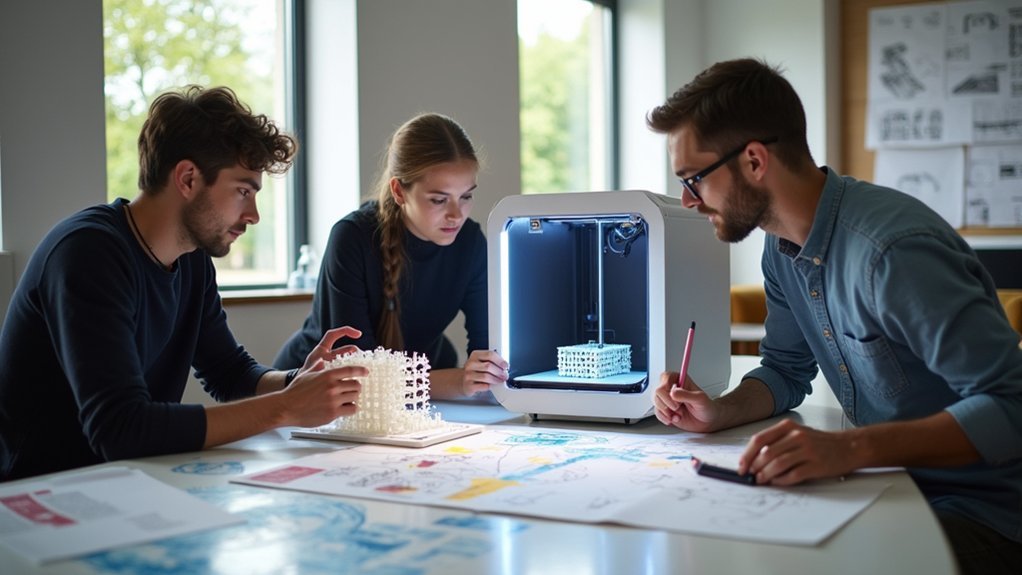Minimum layer time matters for cooling because it prevents heat buildup that can ruin your 3D prints. When layers print too quickly, there’s insufficient time for proper cooling between layers, leading to warping, poor adhesion, and surface defects. Your printer automatically slows down when layers finish too fast, ensuring adequate thermal management. This cooling control is especially essential for intricate details, overhangs, and heat-sensitive materials like Tough PLA. Understanding these cooling dynamics will help you optimize your print settings for superior results.
How Minimum Layer Time Prevents Heat Buildup

One of the most critical aspects of 3D printing is managing heat accumulation between layers, and minimum layer time serves as your primary defense against thermal buildup.
When your printer deposits molten filament, each layer retains significant heat that must dissipate before the next layer arrives. Without adequate cooling time, this heat buildup creates a cascade of problems affecting your print quality.
Your printer automatically slows down when layers complete faster than your minimum layer time setting, ensuring proper thermal management.
Smart printers recognize when layers finish too quickly and automatically reduce speed to prevent damaging heat buildup.
This controlled approach prevents the filament from staying too hot, which would otherwise cause warping, poor layer adhesion, and surface defects.
The Relationship Between Fan Speed and Layer Cooling
Your printer’s fan speed adjusts automatically based on two key thresholds that correspond to layer printing times, ensuring ideal cooling as conditions change throughout your print.
When layers print faster than the minimum threshold, normal fan speed kicks in, but slower layers trigger maximum fan speed to compensate for reduced airflow time.
Different materials like Tough PLA require specific cooling approaches—you’ll need minimum layer times above 20 seconds to prevent heat deformation, making fan speed management critical for material-specific success.
Fan Speed Thresholds
When layers print at different speeds, fan speed thresholds automatically adjust cooling power to maintain perfect print quality. Your printer’s cooling system uses two key thresholds to determine ideal fan speed based on layer print time.
Below the minimum time threshold, maximum cooling kicks in, while above it, normal fan speed applies.
Here’s how fan speed thresholds work:
- Normal fan speed (10%) activates when minimum time exceeds 30 seconds
- Maximum fan speed (80%) engages for printing time under 3 seconds
- Interpolation occurs between thresholds for gradual cooling time adjustments
- Always-on fan operation prevents frequent start-stop cycles
- Automatic adjustment guarantees consistent layer print time cooling
This threshold system guarantees your layers receive appropriate cooling regardless of their printing time, preventing defects while enhancing print quality.
Material-Specific Cooling Requirements
Although all 3D printing materials require cooling, each filament type demands specific fan speed settings to achieve ideal results.
Tough PLA needs minimum layer time above 20 seconds to prevent heat deformation and maintain proper layer adhesion. You’ll want to set normal fan speed to 0% for the first layer to improve bed adhesion and prevent warping.
ABS and PAHT CF15 are sensitive to high fan speeds, which can cause material shrinkage. For these materials, you should reduce cooling to maintain print quality.
PET-G requires minimal cooling under normal conditions, but if you experience delamination, lower your fan speed to preserve layer integrity.
When print speed drops below certain thresholds, maximum fan speed guarantees adequate cooling without compromising quality.
Material-Specific Cooling Requirements and Adjustments

Different materials require specific cooling approaches to achieve ideal print quality, and you’ll need to adjust your minimum layer time settings accordingly.
Temperature-sensitive materials like Tough PLA benefit from extended minimum layer times above 20 seconds, while materials such as PAHT CF15 and ABS require reduced fan speeds during initial layers to prevent warping.
You can fine-tune your fan speed settings by considering each material’s unique thermal properties and adjusting the minimum layer time to accommodate proper cooling without compromising adhesion.
Temperature-Sensitive Material Settings
Since temperature-sensitive materials respond differently to cooling conditions, you’ll need to adjust your minimum layer time settings based on each material’s specific thermal properties.
These adjustments prevent heat deformation and guarantee consistent layer adhesion throughout your print.
Here’s how to optimize settings for common temperature-sensitive materials:
- Tough PLA: Set minimum layer time above 20 seconds to prevent heat deformation and maintain proper layer adhesion.
- PAHT CF15 and ABS: Use 0% fan speed for initial layers, then increase for fine details to prevent warping.
- PET-G: Apply minimal cooling; reduce fan speed if delamination occurs during printing.
- PP GF30: Increase layer height to make normal fan speed more effective for better adhesion.
- All materials: Guarantee layers meet minimum time requirements for sufficient cooling and quality results.
Fan Speed Optimization
While minimum layer time controls how long each layer has to cool, fan speed determines the intensity of that cooling process and requires careful calibration for each material type. You’ll need different approaches for better cooling depending on your filament choice.
| Material | Normal Fan Speed | Minimum Layer Time |
|---|---|---|
| PAHT CF15/ABS | 0% | 10-15 seconds |
| PET-G | 25% | 15-20 seconds |
| Tough PLA | 50-75% | 20+ seconds |
When printing one layer falls below your threshold, maximum fans speed kicks in automatically. This prevents overheating while maintaining quality. You should adjust these thresholds based on your specific material requirements – layers printed slower use normal fan speed, while faster layers gradually increase to maximum for ideal cooling efficiency.
Balancing Print Speed With Optimal Cooling Performance
Although faster print speeds can dramatically reduce production time, you’ll need to carefully balance velocity with cooling requirements to maintain print quality.
When your printer encounters layers that finish too quickly, it automatically reduces print speed to meet the minimum layer time, ensuring proper filament solidification.
Consider these key factors for ideal performance:
- Speed reduction: Your printer slows down when layer time falls below the minimum threshold
- Cooling impact: Up to 40% of total print time can be attributed to cooling requirements
- Material sensitivity: Heat-sensitive filaments like Tough PLA require longer cooling intervals
- Surface quality: Proper cooling prevents warping and deformation
- Time management: Balance speed with cooling needs to avoid unexpected delays
Strategic adjustment of minimum layer time settings helps you achieve consistent results while maximizing efficiency.
Common Cooling Problems and Their Layer Time Solutions

When layer time settings aren’t properly configured, you’ll encounter specific cooling-related defects that can compromise your print’s appearance and structural integrity.
Banding represents one of the most common problems, creating visible horizontal lines across your model when layers cool unevenly due to insufficient layer times. You’ll notice poor surface finishes and dimensional inaccuracies when your printer maintains high speeds without allowing adequate filament cooling between layers.
To resolve these issues, increase your minimum layer time settings, which automatically reduces your printer to minimum speed when layers finish too quickly. This adjustment guarantees proper filament cooling, dramatically improving print quality.
For heat-sensitive materials, extend layer times even further to prevent warping and deformation, creating consistently smooth surfaces throughout your entire print.
Advanced Cooling Settings for Different Print Geometries
Different print geometries demand specific cooling strategies that go beyond basic layer time adjustments, requiring you to configure advanced fan speed controls and dynamic cooling responses.
Your cooling settings must adapt to each geometry’s unique requirements to maintain peak print quality. Intricate details and overhangs benefit from tailored fan speeds that respond to changing layer time conditions throughout your print.
- Configure fan speed thresholds that activate when layer time drops below minimum requirements for complex geometries.
- Enable cool head lift options for tall, thin structures to prevent heat buildup between layers.
- Set dynamic fan speeds for overhangs that automatically increase cooling during challenging sections.
- Adjust minimum layer time based on geometry complexity to guarantee adequate cooling intervals.
- Implement speed-dependent cooling that reduces fan intensity for slower-printing detailed areas.
Optimizing Layer Time for Multi-Material Prints
Multi-material prints introduce thermal management challenges that extend far beyond single-material cooling strategies, as each filament type responds differently to temperature variations and requires specific cooling intervals to achieve proper interlayer adhesion.
You’ll need to balance minimum layer time across different material properties to prevent warping and delamination. Heat-sensitive materials like Tough PLA require minimum layer times above 20 seconds for ideal bonding.
Your cooling settings should account for varying material characteristics throughout the print. While extended cooling can improve surface quality and layer adhesion, it’ll considerably impact print duration—sometimes adding up to 40% to total time.
Experiment with your slicer’s cooling parameters for complex multi-material geometries. Fine-tuning these settings guarantees each material receives adequate cooling without compromising overall print efficiency or quality in multi-material prints.
Frequently Asked Questions
What Is Minimum Layer Time?
Minimum layer time is the duration you set for each layer to cool before printing the next one. It prevents heat buildup that’d cause poor adhesion and surface defects in your prints.
Why Is My 3D Printer Not Enough Cooling?
Your printer lacks sufficient cooling because you’ve got inadequate fan speed settings, poor fan positioning, or no part cooling fan. This prevents proper layer solidification, causing warping, stringing, and poor surface quality.
What Is the Minimum Layer Time for Nylon?
You’ll want to set your minimum layer time between 30 to 60 seconds for nylon printing. This range guarantees proper cooling and prevents warping while maintaining good layer adhesion for quality prints.
What Is the Minimum Layer Time in Klipper?
You’ll find that Klipper’s minimum layer time setting is configurable and varies based on your material and print requirements. You can adjust it from seconds to minutes, with typical values ranging between 5-30 seconds for most materials.





Leave a Reply